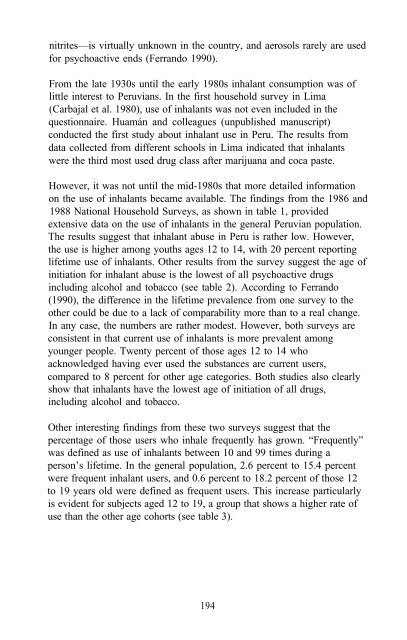Epidemiology of Inhalant Abuse - Archives - National Institute on ...
Epidemiology of Inhalant Abuse - Archives - National Institute on ...
Epidemiology of Inhalant Abuse - Archives - National Institute on ...
Create successful ePaper yourself
Turn your PDF publications into a flip-book with our unique Google optimized e-Paper software.
nitrites—is virtually unknown in the country, and aerosols rarely are used<br />
for psychoactive ends (Ferrando 1990).<br />
From the late 1930s until the early 1980s inhalant c<strong>on</strong>sumpti<strong>on</strong> was <str<strong>on</strong>g>of</str<strong>on</strong>g><br />
little interest to Peruvians. In the first household survey in Lima<br />
(Carbajal et al. 1980), use <str<strong>on</strong>g>of</str<strong>on</strong>g> inhalants was not even included in the<br />
questi<strong>on</strong>naire. Huamán and colleagues (unpublished manuscript)<br />
c<strong>on</strong>ducted the first study about inhalant use in Peru. The results from<br />
data collected from different schools in Lima indicated that inhalants<br />
were the third most used drug class after marijuana and coca paste.<br />
However, it was not until the mid-1980s that more detailed informati<strong>on</strong><br />
<strong>on</strong> the use <str<strong>on</strong>g>of</str<strong>on</strong>g> inhalants became available. The findings from the 1986 and<br />
1988 <str<strong>on</strong>g>Nati<strong>on</strong>al</str<strong>on</strong>g> Household Surveys, as shown in table 1, provided<br />
extensive data <strong>on</strong> the use <str<strong>on</strong>g>of</str<strong>on</strong>g> inhalants in the general Peruvian populati<strong>on</strong>.<br />
The results suggest that inhalant abuse in Peru is rather low. However,<br />
the use is higher am<strong>on</strong>g youths ages 12 to 14, with 20 percent reporting<br />
lifetime use <str<strong>on</strong>g>of</str<strong>on</strong>g> inhalants. Other results from the survey suggest the age <str<strong>on</strong>g>of</str<strong>on</strong>g><br />
initiati<strong>on</strong> for inhalant abuse is the lowest <str<strong>on</strong>g>of</str<strong>on</strong>g> all psychoactive drugs<br />
including alcohol and tobacco (see table 2). According to Ferrando<br />
(1990), the difference in the lifetime prevalence from <strong>on</strong>e survey to the<br />
other could be due to a lack <str<strong>on</strong>g>of</str<strong>on</strong>g> comparability more than to a real change.<br />
In any case, the numbers are rather modest. However, both surveys are<br />
c<strong>on</strong>sistent in that current use <str<strong>on</strong>g>of</str<strong>on</strong>g> inhalants is more prevalent am<strong>on</strong>g<br />
younger people. Twenty percent <str<strong>on</strong>g>of</str<strong>on</strong>g> those ages 12 to 14 who<br />
acknowledged having ever used the substances are current users,<br />
compared to 8 percent for other age categories. Both studies also clearly<br />
show that inhalants have the lowest age <str<strong>on</strong>g>of</str<strong>on</strong>g> initiati<strong>on</strong> <str<strong>on</strong>g>of</str<strong>on</strong>g> all drugs,<br />
including alcohol and tobacco.<br />
Other interesting findings from these two surveys suggest that the<br />
percentage <str<strong>on</strong>g>of</str<strong>on</strong>g> those users who inhale frequently has grown. “Frequently”<br />
was defined as use <str<strong>on</strong>g>of</str<strong>on</strong>g> inhalants between 10 and 99 times during a<br />
pers<strong>on</strong>’s lifetime. In the general populati<strong>on</strong>, 2.6 percent to 15.4 percent<br />
were frequent inhalant users, and 0.6 percent to 18.2 percent <str<strong>on</strong>g>of</str<strong>on</strong>g> those 12<br />
to 19 years old were defined as frequent users. This increase particularly<br />
is evident for subjects aged 12 to 19, a group that shows a higher rate <str<strong>on</strong>g>of</str<strong>on</strong>g><br />
use than the other age cohorts (see table 3).<br />
194
















